
Make sure you have read the Preface for the safety precautions and Chapter 1
for an overview of the installation and replacement procedures and the list of
required tools before proceeding with this chapter.
Complete the procedures in the following sections to prepare your system for
installing or replacing a 5.0 Gbyte 8 mm tape drive.
6.1.1
Powering Off the SCSI Expansion Pedestal
You must first power off the SCSI Expansion Pedestal before proceeding with
the following sections. Refer to the Sun SCSI Expansion Pedestal Installation
Manual (P/N 800-7285-xx) for instructions on safely powering off the pedestal.
6.1.2
Disconnecting the Data Cable
Follow these instructions to disconnect the data cable from the top SCSI tray:
1. Face the rear of the SCSI Expansion Pedestal and locate the data cable
connected to the top SCSI tray port.
The data cable will be plugged into one of the two top SCSI tray ports at the
rear of the pedestal; a terminator will be plugged into the other top SCSI
tray port (see Figure 6-1 for the location of the top SCSI tray ports).

Figure 6-1
Location of the Top SCSI Tray Ports (Rear View)
2. Squeeze the locking tabs on the sides of the connector body on the data
cable and gently pull the connector out from the top SCSI tray port.
Do not remove the terminator from the remaining top SCSI tray port.
6.1.3
Removing the Front Panel
Follow these instructions to remove the front panel from the SCSI Expansion
Pedestal:
1. Face the front of the SCSI Expansion Pedestal and grasp the base of the
front panel (see Figure 6-2).
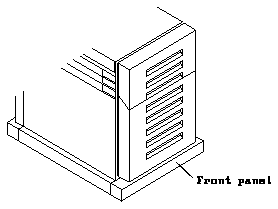
Figure 6-2
Removing the Front Panel and Bumper Assembly
2. Pull sharply on the base of the front panel to disengage the ball studs at
the base, middle, and top of the front panel.
3. Remove the front panel and bumper assembly.
6.1.4
Removing the EMI Front Cover Assembly
Follow these instructions to remove the EMI front cover assembly from the
SCSI Expansion Pedestal:
1. Use the 7 mm hex socket to remove the six M4 hex-head screws (see
Figure 6-3).
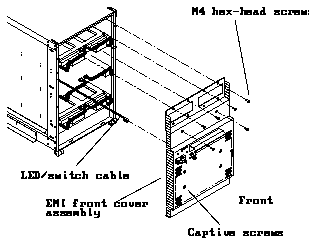
Figure 6-3
EMI Front Cover Assembly Removal
2. Use the flat-head screwdriver to loosen the four captive screws (see
Figure 6-3).
3. Gently pull the cover until it has disengaged from the top of the cabinet.
Grasp the formed handle on the EMI front cover. The cover will still be
connected at the bottom via a slotted bayonet mount.
4. Reach inside the EMI front cover and disconnect the cable that is
connected to the LED/switch PCB assembly (see Figure 6-3).
To disconnect the cable, squeeze the rocker tab on the connector housing
and gently pull away from the printed circuit board assembly. Unclip the
cable from the strain relief, located on the EMI front cover assembly below
the LED/switch PCB assembly.
5. Lift the EMI front cover assembly up to disengage the base from the
bottom of the pedestal frame.
Put the EMI front cover assembly to one side.
6.1.5
Removing the Top SCSI Drive Tray
Follow these instructions to remove the top SCSI drive tray from the pedestal:
1. Face the front of the SCSI Expansion Pedestal and disconnect the DC
harness connectors from the DC connectors mounted in the front of the
SCSI drive tray (see Figure 6-4).
To disconnect the cable, squeeze the rocker tabs on the DC connector
housing and gently pull away from the drive tray DC connector housing.
Move the cables to the side.
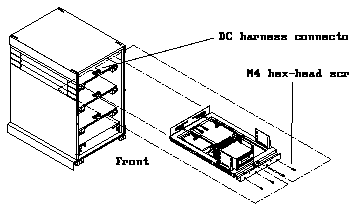
Figure 6-4
Removing the Top SCSI Drive Tray
2. Use the 7 mm hex socket to remove the four M4 hex-head screws (see
Figure 6-4).
3. Gently slide the SCSI drive tray forward and out of the chassis.
4. Set the SCSI drive tray in a safe and secure area.
Caution -

Circuit board components can be damaged by electrostatic discharge
(ESD). An electrostatic charge can build up on the human body and then
discharge when you touch a board or a magnetic storage device, such as a tape
drive. Such discharge can be produced by walking across a carpet and
touching a board, or by any other similar action. Before handling any board or
magnetic storage device, make sure you dissipate your body's charge by
following these instructions carefully.
Follow these instructions to unpack and inspect the drive:
1. Unpack the 5.0 Gbyte 8 mm tape drive.
2. Place the tape drive on top of the bag it was shipped in.
Placing the drive on the bag will prevent static discharge from accumulating
in the device.
3. Inspect the tape drive for evidence of damage.
If damaged, keep all contents and packing materials for the carrier's agent
to inspect.
4. Verify that the shipping container has all the contents you will need to
install the 5.0 Gbyte 8 mm tape drive.
The shipping container should have the following items:
-
one 5.0 Gbyte 8 mm tape drive
-
four manuals, including this one
5. Save packing materials for future use.
Follow these instructions to set the SCSI address on your 5.0 Gbyte 8 mm tape
drive:
1. Determine if there are any jumpers installed on the SCSI ID connector at
the rear of the tape drive (see Figure 6-5 for the location of the SCSI ID
connector).
A jumper is a small sleeve that slides over two adjacent pins in the SCSI ID
connector to provide an electrical connection. If there are jumpers installed
on the SCSI ID connector, remove the jumpers using the needle-nosed pliers.
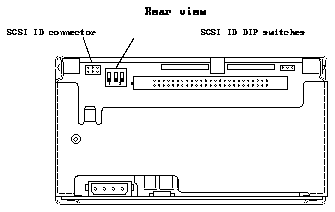
Figure 6-5
Location of the SCSI ID Connector and the SCSI ID DIP Switches on the 5.0
Gbyte 8 mm Tape Drive (Rear View)
2. Determine where you will install the tape drive in the SCSI Expansion
Pedestal.
The tape drive can only be installed in the top tray of your SCSI Expansion
Pedestal, but there are two available locations for the tape drive in the top
tray (see Figure 6-6). The location of the tape drive will determine which
SCSI address it will have.
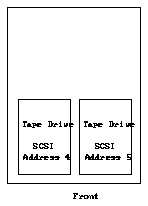
Figure 6-6
Two Tape Drives in the Top Tray
3. Change the settings on the SCSI ID DIP switches to set the correct SCSI
address for the tape drive (see Figure 6-5 for the location of the SCSI ID
DIP switches).
Refer to Table 6-1 and change the settings on the SCSI ID DIP switches to
assign the desired SCSI address.
Table 6-1
SCSI ID Setting
----------------------------------------
SCSI ID Setting DIP Switches Positions
----------------------------------------
4 
5 
----------------------------------------
4. Determine if you will be installing an additional tape drive or replacing
an existing tape drive.
Note -
If you just removed 2.3 or 5.0 Gbyte 8 mm tape drive using the
instructions in Section 6.5, "Removing a 2.3 or 5.0 Gbyte 8 mm Tape Drive,"
then skip to Step 4.
Follow these instructions to install a 5.0 Gbyte 8 mm tape drive in your SCSI
Expansion Pedestal:
1. Face the front of the SCSI drive tray and locate the set of mounting
brackets where you will be installing the 5.0 Gbyte 8 mm tape drive.
Figure 6-7 shows the location of the left and right set of mounting brackets
at the front of the SCSI drive tray.
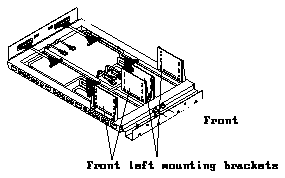
Figure 6-7
Location of Front Mounting Brackets
2. Use the 7 mm hex socket to remove the two M4 hex-head screws holding
the mounting bracket nearest the outer edge of the SCSI drive tray.
Remove that mounting bracket and put it to one side.
3. Use the 7 mm hex socket to loosen the two M4 hex-head screws holding
the mounting bracket nearest the center of the SCSI drive tray.
Slide the mounting bracket out from under the screws and put it to one side.
Do not remove these screws from the SCSI drive tray.
4. Use the Phillips screwdriver to secure the two mounting brackets to the
tape drive using the two 6-32 pan-head screws that were included with the
drive (see Figure 6-8).
Note -
When replacing the drive mounting screws, they must be reinstalled in
the upper threaded locations to ensure proper thread engagement.
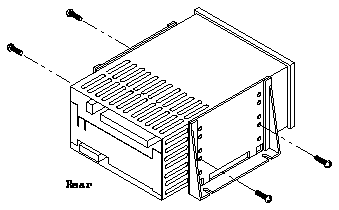
Figure 6-8
Securing the Mounting Brackets to the Tape Drive
5. Position the 5.0 Gbyte 8 mm tape drive in the SCSI drive tray, with the
front of the drive facing the front of the tray.
Gently slide the 5.0 Gbyte 8 mm tape drive towards the center of the SCSI
drive tray until the two screws at the center of the tray are flush against the
inside of the two holes at the bottom of the inner mounting bracket.
6. Insert two M4 hex-head screws in the holes of the outer mounting bracket
(see Figure 6-9).

Figure 6-9
Installing a 5.0 Gbyte 8 mm Tape Drive in the SCSI Drive Tray
7. Use the 7 mm hex socket to tighten all four M4 hex-head screws to secure
the 5.0 Gbyte 8 mm tape drive to the drive tray.
8. Plug the SCSI data cable into the SCSI connector at the rear of the tape
drive (see Figure 6-10).

Figure 6-10
Connector Locations on the 5.0 Gbyte 8 mm Tape Drive (Rear View)
9. Plug the power harness cable into the power connector at the rear of the
tape drive (see Figure 6-10).
10. Go to Section 6.6, "Replacing the Assemblies and Powering On the
Pedestal," to replace the tray and panels on the SCSI Expansion Pedestal.
Follow these instructions to remove an existing 2.3 or 5.0 Gbyte 8 mm tape
drive from your SCSI Expansion Pedestal:
1. Unplug the power cable from the power connector at the rear of the tape
drive.
Grasp the power cable connector on both sides and firmly, but gently, pull
away from the power connector on the tape drive. Figure 6-11 shows the
location of the power connector on the 2.3 Gbyte 8 mm tape drive, and
Figure 6-12 shows the location of the power connector on the 5.0 Gbyte
8 mm tape drive.
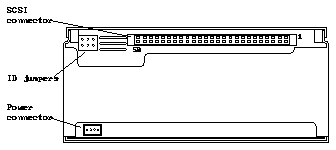
Figure 6-11
SCSI and Power Connector Locations on the 2.3 Gbyte 8 mm Tape Drive
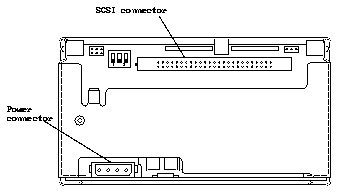
Figure 6-12
SCSI and Power Connector Locations on the 5.0 Gbyte 8 mm Tape Drive
2. Locate the SCSI connector at the rear of the tape drive.
Figure 6-11 shows the location of the SCSI connector on the 2.3 Gbyte 8 mm
tape drive, and Figure 6-12 shows the location of the SCSI connector on the
5.0 Gbyte 8 mm tape drive.
Note -
If you are removing a 2.3 Gbyte 8 mm tape drive from your system, go
to Step 4.
3. Press out on the ejectors at the sides of the SCSI connector on the 5.0
Gbyte 8 mm tape drive to release the SCSI data cable from the drive (see
Figure 6-13).

Figure 6-13
Releasing the Ejectors
4. Grasp the sides of the white plastic tab and slowly pull the SCSI data
cable away from the tape drive (see Figure 6-14).
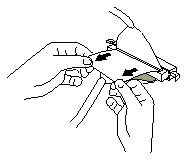
Figure 6-14
Disconnecting the SCSI Data Cable
5. Use the 7 mm hex socket to remove the two M4 hex-head screws holding
the mounting bracket nearest the outer edge of the SCSI drive tray.
Figure 6-15 shows the screws being removed from a tape drive installed in
the front left position in the SCSI drive tray; the procedure is the same for a
tape drive installed in the front right position in the tray.
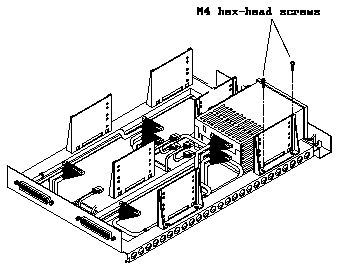
Figure 6-15
Removing the 2.3 or 5.0 Gbyte 8 mm Tape Drive from the SCSI Drive Tray
6. Use the 7 mm hex socket to loosen the two M4 hex-head screws holding
the mounting bracket nearest the center of the SCSI drive tray.
Do not remove these screws from the SCSI drive tray.
7. Gently slide the tape drive towards the outer edge of the SCSI drive tray
until the tape drive is free from the inner two M4 hex-head screws and lift
the tape drive away from the SCSI drive tray.
8. Gently put the tape drive down on an anti-static bag.
9. Use the Phillips screwdriver to remove the two 6-32 pan-head screws that
hold the drive to each of the two mounting brackets (see Figure 6-16).
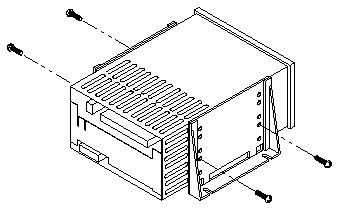
Figure 6-16
Removing the Mounting Brackets from the Tape Drive
10. Go to Section 6.4, "Installing a 5.0 Gbyte 8 mm Tape Drive," to install a
new 5.0 Gbyte 8 mm tape drive in your system.
Complete the procedures in the following sections to replace the assemblies
and power on your SCSI Expansion Pedestal.
6.6.1
Replacing the Top SCSI Drive Tray
Follow these instructions to replace the top SCSI drive tray in the SCSI
Expansion Pedestal:
1. Gently slide the top SCSI drive tray into the chassis (see Figure 6-17).
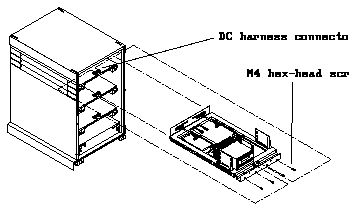
Figure 6-17
Replacing the Top SCSI Drive Tray
2. Connect the DC cable harness connectors to the DC connectors mounted
in the front of the SCSI drive tray (see Figure 6-17).
3. Use the 7 mm hex socket to secure the SCSI drive tray to the chassis using
the four M4 hex-head screws (see Figure 6-17).
6.6.2
Replacing the EMI Front Cover Assembly
Follow these instructions to replace the EMI front cover assembly on the SCSI
Expansion Pedestal:
1. Slide the EMI front cover assembly down along the front of the SCSI
Expansion Pedestal until the base of the EMI front cover assembly is
resting in the slot at the base of the pedestal frame.
2. Reach inside the EMI front cover and connect the cable that is connected
to the LED/switch PCB assembly.
3. Clip the cable using the strain relief, located on the EMI front cover
assembly below the LED/switch PCB assembly.
4. Use the formed handle on the EMI front cover to gently push the cover
toward the SCSI Expansion Pedestal until the cover is pressed up against
the top of the cabinet.
5. Use the flat-head screwdriver to tighten the four captive screws on the
EMI front cover (see Figure 6-18).
Note -
The captive screws on the EMI front cover screw into the bottom and
middle trays in the SCSI Expansion Pedestal, so you may not be able to use the
captive screws if you don't have these trays installed in your pedestal.

Figure 6-18
Replacing the EMI Front Cover Assembly
6. Use the 7 mm hex socket to secure the front cover to the SCSI Expansion
Pedestal using the six M4 hex-head screws (see Figure 6-18).
6.6.3
Replacing the Front Panel
Follow these instructions to replace the front panel on the SCSI Expansion
Pedestal:
1. Press the lower corners of the front panel against the pedestal until you
hear and feel the lower ball studs snap into place.
2. Press the middle sides of the front panel against the pedestal until you
hear and feel the middle ball studs snap into place.
3. Press the top corners of the front panel against the pedestal until you hear
and feel the top ball studs snap into place.
6.6.4
Connecting the Data Cable
To connect the data cable to the SCSI tray port, face the rear of the SCSI
Expansion Pedestal and connect the data cable from the back panel to the
available SCSI tray port on the top tray (see Figure 6-19 for the location of the
top SCSI tray ports). The remaining SCSI tray port should already have a
terminator installed.
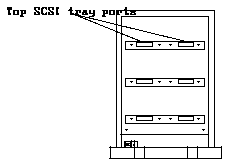
Figure 6-19
Location of the Top SCSI Tray Ports
6.6.5
Powering On the System
Refer to the Sun SCSI Expansion Pedestal Installation Manual (P/N 800-7285-xx)
for instructions on safely powering on the pedestal.
You may have to enter a specific software command when booting the system
so that the system will recognize the new drive; refer to the software handbook
for your operating system for more information. For example, if your system is
running on the Solaris 2.x operating system, you would enter the following
command to boot up the system so that it would recognize the new drive:

Once you have completed the procedure for installing the 5.0 Gbyte 8 mm tape
drive in the SPARCcluster 1 system, you should have the following items
remaining:
-
four manuals, including this one
The mounting brackets were not needed for to install the 5.0 Gbyte 8 mm tape
drive in the SCSI Expansion Pedestal, so you can discard the mounting
brackets; the remaining items will be used when you operate the 5.0 Gbyte
8 mm tape drive.
Follow these procedures if you want to verify that the 5.0 Gbyte 8 mm tape
drive is correctly installed in the SCSI Expansion Pedestal. Refer to the section
entitled "When You Need Help with UNIX Commands" in the Preface of this
manual if you need references to help with the commands or system
administration procedures given below.
1. Notify users that the system is going down.
2. Halt the system using the appropriate commands.
3. Wait for the system-halted message and boot monitor prompt.
Once you have halted your system, you will see several system messages.
-
If you see the "ok" prompt at the end of the system messages, go to Step 4.
-
If you see the following screen at the end of the system messages:

type "n" at the "" prompt and press <return:

This will bring you to the "ok" prompt.
4. Probe your system for SCSI devices.
The command you enter to probe your system for SCSI devices will vary
depending on which system you have your SCSI Expansion Pedestal tray(s)
connected to:
-
If the SCSI Expansion Pedestal is connected to a SPARCstation, enter the
following command:

-
If the SCSI Expansion Pedestal is connected to a SPARCserver 630MP or
670MP, and the top and bottom trays of the SCSI Expansion Pedestal are
connected to the SBus 0 slot on the main CPU board, enter the following
command, leaving a space after every quotation mark ("):

Figure 6-20 shows the location of the SBus slots in a SPARCserver 630MP or
670MP.

Figure 6-20
Location of the SBus Slots on the SPARCserver 630MP or 670MP
-
If the SCSI Expansion Pedestal is connected to a SPARCserver 630MP or
670MP, and the top and bottom trays of the SCSI Expansion Pedestal are
connected to the SBus 1 slot on the main CPU board, enter the following
command, leaving a space after every quotation mark ("):

-
If the SCSI Expansion Pedestal is connected to a SPARCserver 630MP or
670MP, and the top and bottom trays of the SCSI Expansion Pedestal are
connected to the SBus 2 slot on the main CPU board, enter the following
command, leaving a space after every quotation mark ("):

-
If the SCSI Expansion Pedestal is connected to a SPARCserver 630MP or
670MP, and the top and bottom trays of the SCSI Expansion Pedestal are
connected to the SBus 3 slot on the main CPU board, enter the following
command, leaving a space after every quotation mark ("):

5. Verify that the 5.0 Gbyte 8 mm tape drive you just installed is listed.
You should see a list of drives similar to the following:
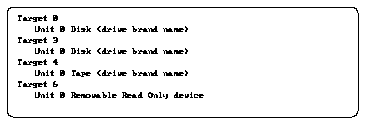
The "Target #" lines will tell you the SCSI addresses of the devices you have
connected to your system.
-
If you see "Target 4" or "Target 5" listed (depending on which SCSI
address you assigned the tape drive), then the drive installation was
successful.
-
If you don't see "Target 4" or "Target 5" listed (depending on which SCSI
address you assigned the tape drive), then verify that the ID address
switch and the cables are installed correctly.
6. Enter the following command to reboot your system:
Your screen will go blank for several seconds after you've entered this
command, and then the system will reboot.



